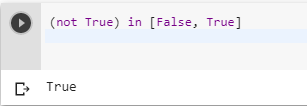You are not getting your desired output due to Operator precedence:-
The precedence of the operator not is lower than the operator in. So it is equivalent to:
>>> not ((True) in [False, True])

To get your desired output you need to write it like as follows:-
>>> (not True) in [False, True]

It should always remember not to write not(True), you should always prefer not True. Writing not(True) makes it look like a function call, while not is an operator, not a function.